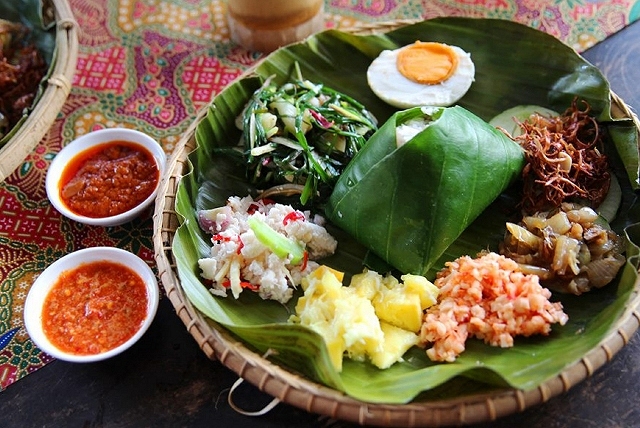The Brunei Malays have their favourite ways of preparing certain food. Breakfast can be savoury – sticky rice cubes or fried rice – sweet with local cakes like pinyaram, katilapam, calak, tapai and kuripit. The midday and late evening meals have more dishes or lauk-pauk served with rice.

Sometimes fish is prepared by boiling, or by grilling. It can also be made into ‘ampap’ which is seasoning the fish with salt, chilli, ‘asam’ (for sourness) and water, then drying it so that the flavouring is absorbed into the fish.
Favoured vegetables are pegaga – small-leafed plant which also has medicinal purposes, lamiding which is wild tender fern shoots, rebung (bamboo shoots), kulat (fungus) and other local greens like cangkuk manis, kangkung and bayam.
By mixing chopped pegaga leaves into the rice, the Brunei Malays believe it can help them live longer and healthier lives!
The Bruneian cuisine is similar to Malay food that can be found in Malaysia. The majority of the dishes are rich and spicy, and are eaten with rice or noodles.
The hawker stalls offer pretty much the same fare, like barbequed fish, chicken wings, satay, kueh melayu and so on. Chinese food such as chicken rice, laksa, noodle dishes and seafood are available at Chinese restaurants. Thosai, tandoori bread and vegetarian fare (occasionally) can be found at many Indian restaurants.
A local speciality is Ambuyat, otherwise known as ‘edible glue’. This is accompanied by grilled fish, a spicy mango sauce and a selection of vegetables. Other local favourites include beef rendang, nasi lemak and puteri nanas.
The peoples of Sabah are blessed with an abundance of seafood, their rivers providing freshwater fish and prawn, with deer, wild board and other game, plus innumerable wild plants, herbs and luscious fruits there for the taking in the forest.
The traditional foods of Sabah’s more than thirty ethnic groups vary, and depend on available resources. Naturally, the diet of coastal peoples was- and still is- dominated by all types of seafood, while those living far inland relied on freshwater fish and wild game. Although both hill rice and padi ( rice planted in irrigated fields ) have been grown in Sabah for generations, this is not always the staple food, and in the far north, corn and cassava ( tapioca ) are often eaten. In many swampy areas, the wild sago palm flourishes. Just how long ago man discovered that it was possible to extract starch from the grated interior of the sago tree is unknown, but the pre- western name for all of Borneo, Kalimantan, comes from the word ‘lamanta’, meaning sago starch.
The Bisaya people of the klias Peninsula, near Brunei, still make a gluey ‘porridge’ with sago starch, ‘ambuyat’, using a pair of chopsticks cut from the rib of the palm to twirl it up into a sticky mass for dunking in a tasty sauce.
Sarawak is famous for its Sarawak Laksa, a local Chinese-style vermicelli dish served hot with chicken and egg shreds, prawns and beansprouts in a bowl of spicy coconut soup cooked with tamarind. This version of laksa is very different from the curry laksa found in other Malaysian sates, thereby proclaiming the uniqueness of the Sarawak Laksa. This delicious yet cheap meal (RM 2.00-3.50 depending on size) is a favourite amongst the locals, and is eaten as breakfast or as a light meal throughout the day. However, you will find that most stalls stop selling laksa by noon. Laksa is conveniently available in hawker stalls or coffee shops as well as restaurants. Other similar local noodle dishes that must not be missed include the popular Kolo Mee, fried Kway Teow, fried noodles (Mee Goreng), Kueh Chap, and Mee Sua.
South East Asia’s finest seafood is best savoured in Sarawak. Most towns in Sarawak are strategically situated close to the sea, and thus receive fresh daily supplies of seafood either from the South China Sea or imported from the waters of Thailand, Indonesia and Sabah (especially during the monsoon season at the end of the year).
Local ikan (fish) come in a wide range, such as the pomphret, red snapper, garoupa, Spanish mackerel, kurau, haruan, terubok and the ray fish. Restaurants serve these fish in numerous ways – steamed, fried, baked, curried, grilled or with sambal – a mild, spicy mixture of Malay origin, made up of onions, dried chillies, candlenuts and belacan (prawn paste).
Crabs, prawns, lobsters, clams, squids, oysters and bamboo clams are equally plentiful and fresh. One can easily find seafood in local restaurants and seafood centres.
Seafood centres specialise in seafood dishes and they usually have a frozen assortment of seafood on display for the customers’ selection. Alternatively, those with more time to spare ought to travel by car to the nearest seafood village located by the beach for a more natural and peaceful ambience while enjoying the catch of the day.
 Food? Please Vote!
Food? Please Vote!


